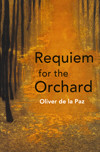Requiem for the Orchard
What’s in an author’s name? Just uttering, “Oliver de la Paz” is to be moved by poetry. Repeating the musicality of such a name over and over before even peeling back the cover to the opening poem makes one ponder, “Could this poet’s name be some sort of predestination statement at the root of his creative process? Or evidence of his introduction since birth to the rise and fall of words that have fine-tuned his ear?”
What’s in an author’s name? Just uttering, “Oliver de la Paz” is to be moved by poetry. Repeating the musicality of such a name over and over before even peeling back the cover to the opening poem makes one ponder, “Could this poet’s name be some sort of predestination statement at the root of his creative process? Or evidence of his introduction since birth to the rise and fall of words that have fine-tuned his ear?”
Coincidentally, I didn’t have to go very far before discovering on page 11 a childhood perspective poem titled, “Sticks and Stones” where the author explores his name in great detail with humor. Here are some of my favorite plucked lines:
When I was a child, I was afraid of my name.
…I’d recite my name until it sounded of helicopter blades or ghosts.
Oliver, Oliver, Oliver soon morphed into ah! liver!
…One child, later, wanted to eat my name.
…Dead in the water. Other children would resuscitate it
so that the name was constant as wind through canyons.
The constant I’ve enjoyed immensely from de la Paz is his use of a variety of sense words to help readers imagine and practically “feel” sounds, visuals, tastes, smells and the tactile. He also has a knack for overlapping or mixing the senses which is referred to as synaesthesia. I compare his talent playing the inked pen to the range of a master blues musician who has a foundation playing spirituals. The music of his words and captivating, concrete images are very balanced. His instrumentation of word choice, placement, contrasts, traces of religious elements, and voice effectively communicate highs and lows. He writes real – without reservation – and from the gut.
Many of de la Paz’s poems resonate and bite with some shock value, long after reading. Requiem for the Orchard bears much fruit, from juice to ooze, when it comes to showcasing a collection that’s polished without sacrificing a flavorful, raw honesty and edge that readers hunger for. Oliver de la Paz’s subject matter attracts us with both the rottenness and the ripeness at the core of every day rural life.
However, between his works about wringing a chicken’s neck, knifing a dead chestnut horse and ghost hunting, I believe one of the most intriguing chanced upon poems of his is on page 57 titled, “Instead, I’m here to tell you very softly.” I personally interpret it as an unrequited love poem. Here his words just flow along with rainy imagery of colorful chalk paintings spilling into sewers. The descriptions conjure the haunting beauty of broken heart ruins, love abandoned, and the gnaw of “want.” Writing with such delicate vulnerability almost went unnoticed at first glance. The striking, seductive nature of this poem took me by surprise. Instead, I’m here to tell you all very loudly that this seemingly more silent, subtle piece came through loud and clear as perhaps one of de la Paz’s most heartfelt. I’d equate it to being like a whisper that’s so quiet and of importance, everyone in the church can and must hear it. And this book is without a doubt my best pick of summer yet!





